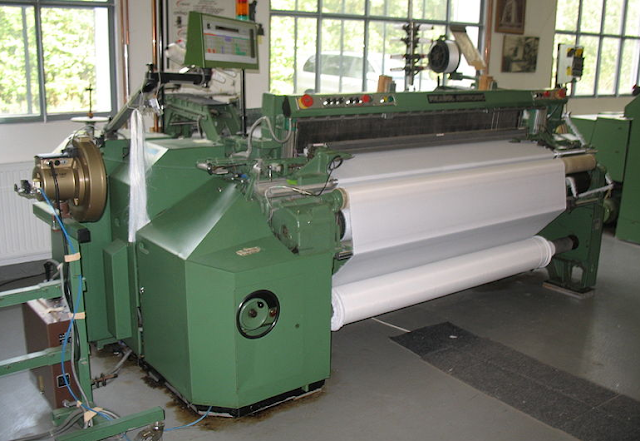Weaving is a process through which a sheet of yarn is converted into fabric. There are 3 primary motions involved in weaving process- shedding, picking and beat up.

Weaving machine.
When weaving operation takes place?
After yarn winding operation the yarn packages are set in one or more creels. This process is called creeling. After creeling warping operations takes place where warp beam is produced. Then the sheet of warp yarn goes through sizing/ slashing process where additional strength is being added to the warp yarn. Then finally the sized sheet of yarn goes through weaving process.
Types of weaving machine:
Weaving machines can be broadly divided into 2 types depending on weft insertion mechanism.
1. Single phase weaving.
2. Multi phase weaving.
Single phase weaving m/c:
- In single phase weaving the 3 primary motions of weaving (shedding, picking, beat up) occurs in a sequential way.
- No simultaneous operation occurs here.
- Per pick (weft yarn) insertion occurs at a specific time interval.
Single phase weaving m/c can be further divided into:
1. Shuttle weaving
Here a device called shuttle is used to transfer the weft yarn from one end of shed to another.
Shuttle loom can be divided into:
A. Hand loom.
B. Fly shuttle.
C. Power loom.
D. Automatic loom.

Shuttle loom.
I. Hand loom: In the early periods of civilization hand looms were used. The entire process of fabric production was done manually without the help of any automated device.
Hand loom can be further divided into:
2. Back strap loom: Here one end of the loom stays fixed and other end is wrapped around the weaver. Shuttle is inserted manually.
II. Fly shuttle: Invented in 1733 by John kay. The machine was hand operated. There was a coed that was used to propel the shuttle through the shed. The cord was operated by hand. As the Shuttle flew through the shed that’s why the shuttle was called fly shuttle.
III. Power loom: The first power loom was designed in 1784 by Edmund Cartwright and first built in 1785. There was a separate electric motor for each loom that was used to operate the loom. This loom drive concept has remained unchanged till now.
IV. Automatic loom: It was invented by R. Millar in 1796. Hare the machine automatically stops in case of any short pick (the pick fails to reach the other end of the shed). Also there was a mechanism of automatic weft replenishment without stopping the loom. There are mainly 2 types of automatic loom.
- Automatic shuttle change.
- Automatic pirn change.
2. Shuttle less weaving m/c: In this type if weaving m/c shuttle is not used. As a result the time needed for the replenishment of shuttle can be eliminated.
There are mainly 3 types of shuttle less weaving m/c. They are-
A. Projectile weaving machine.
B. Rapier weaving machine.
C. Jet weaving machine.
I. Projectile weaving machine: There is one or multiple gripper projectiles used in weaving that carries the weft yarn through the shed.
2. Multiple projectile (unilateral picking): The projectile picks the yarn and travels through the shed and then through a conveyor belt, the projectile comes back to its original position. Here multiple projectile is used to maintain the speed of the loom. Multiple projectile is normally used now a days.
Also read:
Advantages and disadvantages of different shuttle less modern weaving machines
II. Rapier weaving machine: Here a device called rapier is used for carrying the weft yarn. One end of rapier carries the yarn and other end of rapier is connected to the control system.

Rapier weaving machine
- Single rigid rapier: There is one single rapier that carries the weft yarn from one end of the shed to another.
- Double rigid rapier: Here one rapier carries the weft yarn halfway through the shed and then handover the yarn to a second rapier. The second rapier carries the yarn to the opposite side.
- Single flexible rapier: There is one single rapier that carries the weft but the rapier is flexible and can stay coiled.
- Double flexible rapier: There are two rapiers just like the double rigid one but here both the rapiers are flexible.
- Double telescope rapier: There are two rapiers used here but the rapiers are housed in a small box from which rapiers come out. It significantly decreased the space requirement.
III. Jet weaving machine: Here high force of water or air is used to send the weft yarn through the shed.

Jet weaving machine
There are mainly two types of jet weaving machine. They are-
- Air jet weaving machine: There are 2 types of nozzle system used. One is Single jet where only main nozzle is used in order to propel the weft yarn and the other is multi jet where there is a back up nozzle along with the main nozzle.
- Water jet weaving: In water jet weaving a stream of water is used to propel the weft yarn through the shed. Water jet weaving is only suitable for hydrophobic yarn.
2. Multi-phase weaving machine:
- In multi-phase weaving the 3 primary motions of weaving (shedding, picking, beat up) occurs in a simulations way.
- There is no specific time interval between per pick (weft yarn) insertion.
- Increased production rate.
- Machine can be circular or flat bed.





0 Comments